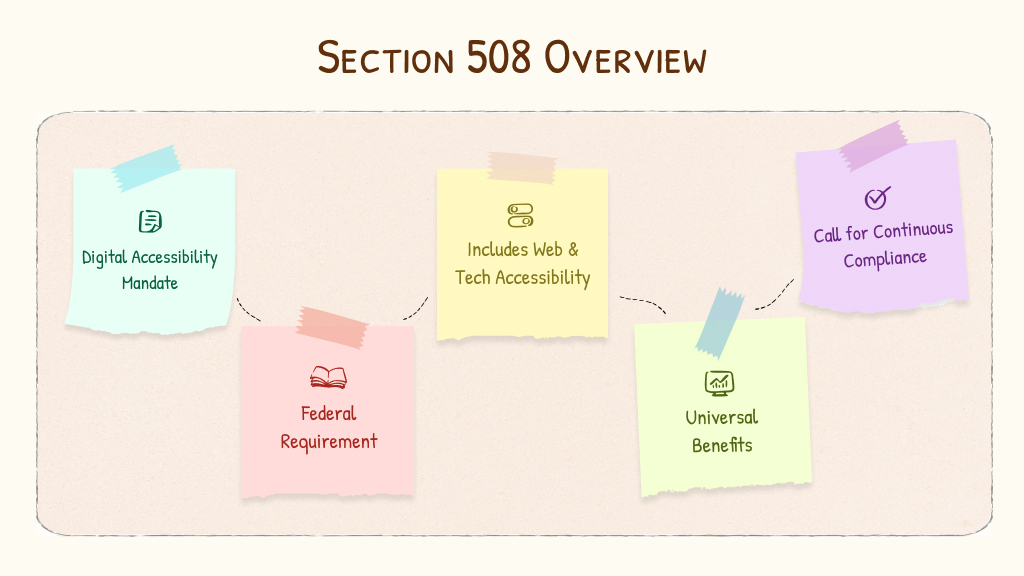- Categories (3)
- Guides - Platform
- Guides - Reviews
- Technical
Mastering Section 508: A Complete Guide to Accessibility Compliance
Enacted in 1998, Section 508 now forms an integral part of complying with web accessibility requirements.
Along with being aware of digital accessibility standards mentioned in global disability acts such as the ADA, businesses also need to take Section 508 into account if they want to avoid costly penalties and brand-damaging lawsuits.
In this guide, we’re going to take you through everything you need to know to ensure full compliance.
Let’s dive right in
What is Section 508?
Due to a rise in awareness of legislation required to accommodate the needs of Americans with disabilities, the Rehabilitation Act of 1973 was signed into law (1).
From its creation until the late 1990s, the Rehabilitation Act was reworked and revised, at times specifically to address issues related to technology and accessibility. In 1998, Section 508 was added to the act. This was an amendment requiring government websites and media to create, use, and maintain site content and technology that is accessible to people with disabilities.

A Brief History of Section 508
It was in 1998 that the Rehabilitation Act of 1973 was amended to ensure that all electronic and information technology was accessible to people with disabilities. This also resulted in the amendment of Section 508, making it more relevant and effective.
This particular amendment was developed by the U.S. Access Board, which deals specifically with Information and Communication Technology (ICT) accessibility standards.
In 2017, the Access Board further updated the accessibility requirements covered under Section 508 to refresh guidelines, with the final rule coming into effect in early 2018. This update was linked to market trends and new technological innovations. It also created better synchronicity between other accessibility standards, including the Web Content Accessibility Guidelines (WCAG 2.0).
Section 508 Technical Standards Outlined
Let’s take a closer look at some of the main technical standards covered under Section 508.
- Users with fine motor skill impairments need to be able to perform functions using a keyboard alone. This requires the implementation of the proper HTML code structures.
- Any interactive elements on-screen should be clearly highlighted upon receiving focus.
- Text alternatives for non-text elements are required. Alt text on images and text transcripts for audio recordings are prime examples.
- The correct color contrast ratios should be applied and color alone should never be used to convey meaning.
- Documents should be organized in a way that doesn’t require an associated style sheet. Web pages also shouldn’t require a Cascading Style Sheet (CSS) for viewing or navigation.

- If server-side image maps are necessary, an alternative way to display this information needs to be implemented to make it compatible with screen readers.
- Tables should be carefully coded to clearly indicate whether a cell is a header, column, or row, making it easier for assistive technology to interpret.
- Any embedded content should be placed in an inline frame container or iframe having an accessible name.
- Any flickering or flashing content should be limited or removed completely. If it is used, objects should not flash more than 3 times per second.
- If users require an applet, software, or a plugin to interpret content, a link must be provided.
- Any form must be compatible with assistive technology and be navigable with a keyboard alone.
- Users should be able to skip repetitive navigation links and block.
- Users must be given sufficient notice that a timed response is in place and have the ability to indicate that more time is required.
What is the 2017 update to Section 508?
Section 508 (2) was updated once again In March 2017. This important update included accessibility requirements for information and communication technology. The goal was to bring the requirements of Section 508, originally laid out nearly 45 years earlier, up to date with the realities of technology and how we use and interact with it in the 21st century.

The major changes included in the 2017 revision include:
– Any content related or aimed toward the general public needs to be accessible to people with disabilities, including those with impairments like visual, hearing, language, and motor.
– Software and operating systems are required to be compatible with various assistive technologies (for example, screen readers).
– WCAG 2.0 Level AA compliance is required for most federal websites and includes 38 success criteria (3).
Why does Section 508 matter for my business?
Section 508 applies to any company that does business with federal agencies and departments, as well as any company that does business with a federal agency. This can include a range of businesses, including healthcare providers, legal organizations, private contractors, and others. Section 508 is crucial to people with disabilities, as, without it, they would not be able to navigate, comprehend, or have access to critical online information.

When your business ignores compliance standards, it is missing out on serving the needs of a large and important group of users. Just as you would take steps to accommodate people with disabilities in a brick and mortar store, so too should website owners see their spaces online.
Without Section 508, it would be a lot easier for businesses and government agencies to not consider accessibility at all.
The knock-on effect is that people living with disabilities could potentially miss out on important information and services, including announcements and updates from agencies such as the SSA and IRS.
Section 508 is what keeps agencies accountable, ensuring all Americans are included in important updates and notices.
A Fast and Efficient Way to Comply with Web Accessibility Guidelines
Our top-recommended web accessibility solution is accessiBe. This advanced AI-powered tool makes it easier to apply the latest WCAG standards to your site by simply adding a line of code to the back-end.
What Documents are Included Under Section 508?
If you are a government entity or your business receives federal funding, any digital communications you produce need to be accessible. This includes website content, PDFs, email communication, and apps.
All too often we assume that websites and PDFs are automatically accessible, but this is not the case. A remediation process is needed before we can be sure that technology such as screen readers can access and interpret information.
What’s the difference between the ADA and Section 508?
The most important compliance regulatory bodies to know for U.S based businesses are the WCAG, the ADA, and Section 508. The WCAG forms the basis of other compliance standards, but you might still be wondering, how exactly do Section 508 and the ADA differ?

To put it simply, Section 508 is a federal law that applies to federal agencies and departments, whereas ADA is a civil rights law that applies to public and private sector.
What are the next steps?
Now that you understand the importance of website accessibility compliance, it’s time to take action.
Most website owners are not sure where their website stands in terms of compliance standards. Some have accessibility plugins installed, but that does not make a website fully compliant.
The best place to start is with a quick website audit. This will give you an overview of where you stand and what steps you need to take in order to avoid costly mistakes and lawsuits. You can begin your free website audit here.
Accessibility Checker
Scan your website for accessibility related issues for free
Section 508 compliance means federal agencies are required to secure, maintain, and use Information and Communications Technology (ICT) that can be accessed by those living with disabilities. Whether or not they work for the federal government is not relevant.
Section 508 of the Rehabilitation Act refers to the steps that federal agencies need to take to ensure that people living with disabilities can access their products and services. This is done by acquiring, maintaining, and using the right Information and Communications Technology.
Section 508 doesn’t apply to privately owned websites, including individuals and private businesses. However, it does apply to all federal websites and electronic materials.
To comply with Section 508, start by familiarizing yourself with the Website Content Accessibility Guidelines (WCAG), which offers clear recommendations on how to be compliant. Next, conduct an audit of your website to identify the accessibility issues that you need to rectify. Elements you may need to work on include images, videos, headers, and color contrast.
There are a number of requirements related to being compliant with section 508. Overall, website owners need to make adjustments to their sites that will ensure any online content and products are fully accessible to all visitors, including those with disabilities. Section 508 is based on the Web Content Accessibility Guidelines (WCAG) – a good starting point for compliance.
Section 508 testing allows a business to test their website and digital content against the Web Content Accessibility Guidelines (WCAG), which ensure people with disabilities have full access.


